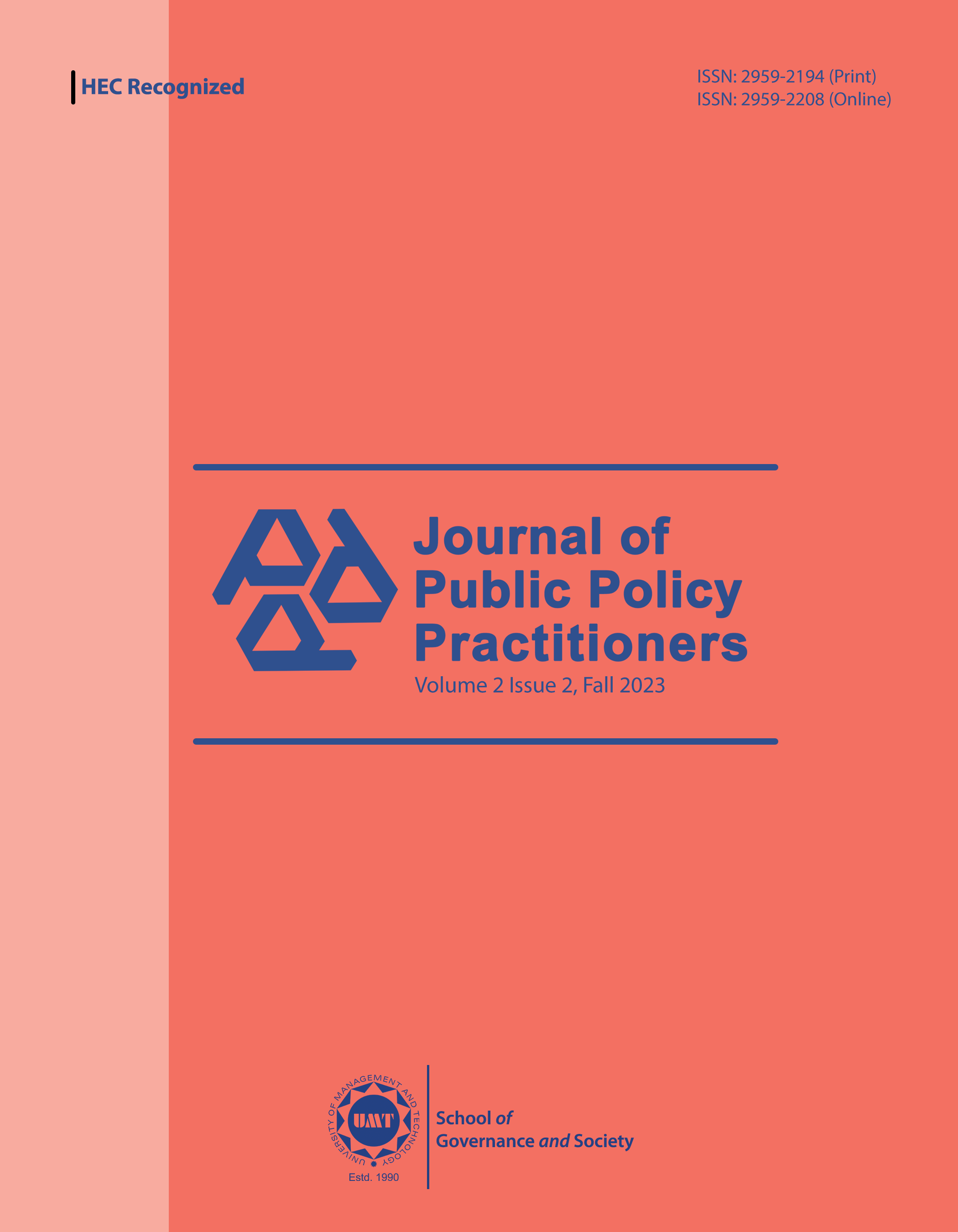Pakistan's Struggle for Regional Economic Dominance: Analyzing Failures and Proposing Essential Policy Interventions
Abstract
 Abstract Views: 0
Abstract Views: 0
This policy paper is an inquisitive effort from a vantage point which aims to explore Pakistan’s economic prospects and identifies the key systemic issue of governance that has hampered Pakistan’s potential for regional economic dominance and requires intervention on priority. This paper underscores the critical role of system theory in policymaking, particularly when paralysis ensues due to intricate issues within the public sector. It advocates for a strategic approach by identifying key intervention areas and emphasizes the importance of adhering to broader governance principles within one's sphere of influence. Additionally, it subtly touches upon the impact of foreign aid and political instability on economic growth. Through survey, statistics and literature review, this research narrows down the interventions necessary to navigate the challenging public policy regime in order to meet the objective of regional economic prosperity. It inspires the policymakers to contribute through the economic prism in their own area of influence for sustainable economic growth, instead of being trapped into inculpation.
Downloads
References
Abate, C. A. (2022). The relationship between aid and economic growth of developing countries: Does institutional quality and economic freedom matter? Cogent Economics & Finance, 10(1), Article e2062092. https://doi.org/10.1080/23322039.2022.2062092
Arend, M., & Sánchez, P. (2020). Determinants of sovereign risk and differences between developed and emerging countries. Consejo Fiscal Autonomo.
Atiq, S. K. (2020, March 12). Pakistan’s 2020 real estate prospects and challenges. Profit. https://profit.pakistantoday.com.pk/2020/03/12/ pakistans-2020-real-estate-prospects-and-challenges/
Bayar, Y. (2016). Public governance and economic growth in the transitional economies of the European union. Transylvanian Review of Administrative Sciences, 12(48), 5–18. https://www.rtsa.ro/tras/index. php/tras/article/view/480/469
Government of Pakistan. (2023). Economic survey of Pakistan 2022-23. https://www.finance.gov.pk/survey/chapters_23/Economic_Survey_2022_23.pdf
Government of Pakistan. (2007). Vision 2030. https://faolex.fao.org/docs/pdf/pak149943.pdf
Government of Pakistan. (2014). Vision 2025. https://faolex.fao.org/docs/pdf/pak166456.pdf
Government of Pakistan. (2022). National security policy 2022-26. National Security Policy 2022-26. https://www.nsd.gov.pk/SiteImage/Misc/files/NSP%20summary.pdf
Guagenti, C. (2023, July 14). USD To CNY: Convert United States Dollar to Chinese Yuan. Forbes Advisor. https://www.forbes.com/advisor/ money-transfer/currency-converter/usd-cny/?amount=1
HSGUniStGallen. (2015, February 18). Public value – common good and the society [Video]. YouTube. https://www.youtube.com/ watch?v=tLGAQ4q_Sb0
International Monetary Fund. Asia and Pacific Dept. (2023). Regional economic outlook: Asia and Pacific, May 2023. International Monetary Fund. https://doi.org/10.5089/9798400238062.086
Johnson, W. (1994). Economic dominance. In W. Johnson (Ed.), Dismantling apartheid: A South African Town in Transition (pp. 137–154). Cornell University Press. https://doi.org/10.7591/9781501721830-007
Mauricio, L. (2010, December 6). Pakistan debt crisis of 1998: Fueled by nuclear power and political instability. Machetemag. http://www.machetemag.com/policy-global-development/economics-cat/pakistan-debt-crisis-of-1998-fueled-by-nuclear-power-and-political-instability/
Pasha, H. A. (2023). Leading issues in the economy of Pakistan: Agenda for reforms. Friedrich-Ebert-Stiftung. https://library.fes.de/pdf-files/bueros/pakistan/20169.pdf
Planning & Development Board. (n.d.). Irrigation Sector. Government of the Punjab. https://pnd.punjab.gov.pk/pcirrigationsector
Razaq, A., Nazir, R., Adil, F., & Akhtar, M. (2020). Democracy, governance and economic growth: Time series evidence from Pakistan. Journal of Economics and Economic Education Research, 21(3), 1–14.
Rjonesx. (2022). Factors of production. Finance Reference. https://www.financereference.com/factors-of-production/
Sarwar, A., Hassan, M., & Mahmood, T. (2015). Foreign aid and governance in Pakistan. Pakistan Economic and Social Review, 53(2), 149–176.
Shahbaz, M., Ahmad, K., & Chaudhary, A. R. (2008). Economic growth and its determinants in Pakistan. The Pakistan Development Review, 47(4), 471–486.
Statista. (2023, June 30). The 30 largest countries in the world by total area. https://www.statista.com/statistics/262955/largest-countries-in-the-world/
The Global Economy. (n.d.). Political stability-Country rankings. https://www.theglobaleconomy.com/rankings/wb_political_stability/
The World Bank. (2022, November 10). Pakistan urgently needs significant investments in climate resilience to secure its economy and reduce poverty. https://tinyurl.com/3eavj37v
The World Bank. (n.d.-a). The World Bank open data. https://data.worldbank.org/?locations=PK-IN-BD-CN-IR
The World Bank. (n.d.-b). The World Bank open data. https://data.worldbank.org/indicator/IC.BUS.EASE.XQ?locations=PK-IR-CN-IN-BD
Trade Map. (n.d.). Bilateral Trade between Pakistan and World in 2022. Product: Total all Products. International Trade Centre. https://www.trademap.org/Bilateral.aspx?nvpm=1%7c586%7c%7c000%7c%7cTOTAL%7c%7c%7c2%7c1%7c1%7c2%7c1%7c1%7c1%7c1%7c1%7c1
United Nations Development Program. (n.d.-a). Country insights. Human Development Reports. https://hdr.undp.org/data-center/country-insights#/ranks
United Nations Development Program. (n.d.-b). E-Government Development Index [Dataset]. https://publicadministration.un.org/egovkb/en-us/Data-Center
Zubair, S. S., & Khan, M. (2014). Good governance: Pakistan’s economic growth and worldwide governance indicators. Pakistan Journal of Commerce and Social Sciences, 8(1), 258–271.
Copyright (c) 2023 Muhammad Umair

This work is licensed under a Creative Commons Attribution 4.0 International License.







